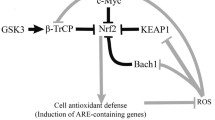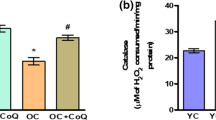Abstract
Xanthine oxidase (XO) is an important source of oxidant production and plays an essential role in several oxidative stress-related diseases. Aging is associated with a progressive deregulation of homeostasis as a result of a chronic oxidative stress situation. In the present work the age-related changes in XO expression and activity, as well as the activities of superoxide dismutase and catalase have been investigated in liver, kidney and thymus from four different age groups of mice, including long-lived animals. Furthermore, we have evaluated the contribution of the XO to the oxidative stress-associated with aging, in comparison to another enzymatic key source of oxidant generation, the NADPH oxidase, in peritoneal leukocytes from old mice. In all the tissues analyzed, the old mice showed higher activity and expression of XO, and decreased or unchanged superoxide dismutase and catalase activities as compared with adult mice. Moreover, the inhibition of reactive oxygen species with allopurinol or apocynin in peritoneal leukocytes from old mice, suggest that both XO and NADPH oxidase contribute to the generation of superoxide anion, whereas the XO may have a special relevance in the production of hydrogen peroxyde. Finally, long-lived animals showed a well-preserved redox state, in terms of antioxidant defenses and oxidant compounds in tissues and immune cells, which may be related to the ability of these subjects to reach a very advanced age in healthy condition. These results confirm that XO plays an important role in the age-related oxidative stress in tissues and immune cells.






Similar content being viewed by others
References
Aebi H (1984) Catalase in vitro. In: Packer L (ed) Methods in enzymology, vol 105. Academic Press, Orland, pp 121–126
Alonso-Fernández P, De la Fuente M (2011) Role of the immune system in aging and longevity. Curr Aging Sci 4(2):78–100
Alonso-Fernandez P, Puerto M, Maté I, Ribera JM, De la Fuente M (2008) Neutrophils of centenarians show function levels similar to those of young adults. J Am Geriatrics Soc 56:2244–2251
Alvarado C, Álvarez P, Jiménez L, De la Fuente M (2006) Oxidative stress in leukocytes from young prematurely aging mice is reversed by supplementation with biscuits rich in antioxidants. Dev Comp Immunol 30:1168–1180
Ames BN, Shigenaga MK, Hagen TM (1993) Oxidants, antioxidants, and the degenerative diseases of aging. Proc Natl Acad Sci USA 90:7915–7922
Aranda R, Doménech E, Rus AD et al (2007) Age-related increase in xanthine oxidase activity in human plasma and rat tissues. Free Radic Res 41(11):1995–2000
Arranz L, Caamaño JH, Lord JM, De la Fuente M (2010a) Preserved immune functions and controlled leukocyte oxidative stress in naturally long-lived mice: possible role of nuclear factor kappa β. J Gerontol A Biol Sci Med Sci 65A(9):941–950
Arranz L, Lord JM, De la Fuente M (2010b) Preserved ex vivo inflammatory status and cytokine responses in naturally long-lived mice. Age 32:451–466
Barja G (2004) Free radicals and aging. Trends Neurosci 27:595–600
Berry CE, Hare JM (2004) Xanthine oxidoreductase and cardiovascular disease: molecular mechanism and pathophysiological implications. J Physiol 555:589–606
Cand F, Verdetti J (2003) Superoxide dismutase, glutathione peroxidase, catalase and lipid peroxidation in the major organs of the aging rats. Free Rad Bio Med 7(1):59–63
Cejková J, Vejrazka M, Pláteník J, Stípek S (2004) Age-related changes in superoxide dismutase, glutathione peroxidase, catalase and xanthine oxidoreductase/xanthine oxidase activities in the rabbit cornea. Exp Gerontol 39:1537–1543
Chung HY, Song SH et al (1999) Modulation of renal xanthine oxidoreductase in aging: gene expression and reactive oxygen species generation. J Nutr Health Aging 3:19–23
De la Fuente M (1985) Changes in the macrophage function with aging. Comp Biochem Physiol A Comp Physiol 1(4):935–938
De la Fuente M (2008) Role of neuroimmunomodulation in aging. Neuroimmunomodulation 15:213–223
De la Fuente M (2010) Murine models of premature ageing for the study of diet-induced immune changes: improvement of leukocyte functions in two strains of old prematurely ageing mice by dietary supplementation with sulphur-containing antioxidants. Proc Nutr Soc 69:651–659
De la Fuente M, Miquel J (2009) An update of the oxidation-inflammation theory of aging: the involvement of the immune system in oxi-inflamm-aging. Curr Pharm Des 15:3003–3026
Del Maestro RF, McDonald W, Anderson R (1983) Superoxide dismutase, catalase and glutathione peroxidase in experimental and human brain tumours in oxy radicals and their scavenger systems. In: Greenwald R, Cohen G (eds) Oxy radicals and their scavenger systems. Elsevier, New York, pp 28–35
Desco M, Asensi M, Márquez R et al (2002) Xanthine oxidase is involved in free radical production in type 1 diabetes, protection by allopurinol. Diabetes 1(4):1118–1124
Elahi MM, Kong YX, Matata BM (2009) Oxidative stress as a mediator of cardiovascular disease. Oxid Med Cell Longev 2(5):259–269
Fridovich I (1978) The biology of oxygen radicals. Science 201:875–880
Guayerbas N, Puerto M, Víctor VM, Miquel J, De la Fuente M (2002) Leukocyte function and life span in a murine model of premature immunosenescence. Exp Gerontol 37:249–256
Halliwell B, Gutteridge JM (1990) Role of free radicals and catalytic metal ions in human disease: an overview. Methods Enzymol 186:1–85
Hansson RO, Jonson O, Lundstam S (1983) Effects of free radicals scavengers on renal circulation after ischemia in the rabbit. Clin Sci 65:605–610
Harman D (1956) Aging: a theory based on free radicals and radiation chemistry. J Gerontol 11:298–300
Harris ED (1992) Regulation of antioxidant enzymes. FASEB J 6:2675–2683
Harrison R (2002) Structure and function of xanthine oxidoreductase: where are we know? Free Radic Biol Med 6(33):774–796
Harrison R (2004) Physiological roles of xanthine oxidoreductase. Drug Metab Rev 36(2):363–375
Hassoun PM, Yu FS, Shedd AL et al (1986) Regulation of endothelial cell xanthine dehydrogenase/xanthine oxidase gene expression by oxygen tension. Am J Physiol Lung Cell Mol Physiol 266:L163–L171
Hearse DJ, Manning AS, Downey JM (1986) Liver xanthine oxidase, critical mediator of myocardial injury during ischemia and reperfusion. Acta Physiol Scand 97:100–104
Jacobson A, Yan C, Gao Q, Rincon-Skinner T, Rivera A, Edwards J, Huang A, Kaley G, Sun D (2007) Aging enhances pressure-induced arterial superoxide formation. Am J Physiol Heart Circ Physiol 293:H1344–H1350
Kasapoglu M, Ozben T (2001) Alterations on antioxidant enzymes and oxidative stress markers in aging. Exp Gerontol 36:209–220
Kelley EE, Khoo KH, Hundley NJ et al (2010) Hydrogen peroxide is the major oxidant product of xanthine oxidase. Free Radic Biol Med 48:493–498
Komaki Y, Sugiura H, Koarai A et al (2005) Cytokine-mediated xanthine oxidase upregulation in chronic obstructive pulmonary disease’s airways. Pulmonary Pharm Therap 18:297–302
Kurosaki M, Calzi ML, Scanziani E, Garttini E, Terao M (1994) Tissue and cell specific expression of mouse xanthine oxidoreductase gene in vivo: regulation by bacterial lipopolysaccharide. Biochem J 306:225–234
Liscovsky MV, Ranocchia RP, Alignani DO, Gorlino CV, Morón G, Maletto BA, Pistoresi-Palencia MC (2011) CpG-ODN+IFN-γ confer pro- and anti-inflammatory properties to peritoneal macrophages in aged mice. Exp Gerontol. doi:10.1016/j.exger.2011.01.006.
Marklund S, Marklund G (1974) Involvement of the superoxide anion radical in the autoxidation of pyrogallol and a convenient assay for superoxide dismutase. Eur J Biochem 47(3):469–474
Martin H, Hancock J, Salisbury V, Harrison R (2004) Role of xanthine oxidoreductase as an antimicrobial agent. Infec Immun 72(9):4933–4939
Newaz MA, Yousefipuour Z, Oyekan A (2006) Oxidative stress-associated vascular aging is xanthine oxidase-dependent but not NAD(P)H oxidase-dependent. J Cardiovasc Pharmacol 48:88–94
Parks DA, Granger DN (1986) Xanthine oxidase: biochemistry, distribution and physiology. Acta Physiol Scand Suppl 548:87–99
Parks DA, Skinner KA, Skinner HB, Tan S (1998) Multiple organ dysfunction syndrome: role of xanthine oxidase and nitric oxide. Pathophysiology 5:49–66
Posadas SJ, Caz V, Largo C et al (2009) Protective effect of supercritical fluid rosemary extract, Rosmarinus officinalis, on antioxidants of major organs of aged rats. Exp Gerontol 44(6–7):383–389
Puerto M, Guayerbas G, Víctor VM, De la Fuente (2002) Effects of N-acetylcysteine on macrophage and lymphocyte functions in a mouse model of premature ageing. Pharmacol Biochem Behav 73:797–804
Salmon AB, Richardson A, Pérez VI (2010) Update on the oxidative stress theory of aging: does oxidative stress play a role in aging or health aging? Free Rad Biol Med 48:642–655
Sastre J, Pallardó FV, Viña J (2003) The role of mitochondrial oxidative stress in aging. Free Radic Biol Med 35:1–8
Sobocanee S, Balog T, Kusic B (2008) Differential response to lipid peroxidation in male and female mice with age: correlation of antioxidant enzymes matters. Biogerontology 9:335–343
Tian L, Cai Q, Wey H (1998) Alterations of antioxidant enzymes and oxidative damage to macromolecules in different organs of rats during aging. Free Radic Biol Med 24(9):1477–1484
Tripathi P, Chandra M, Misra MK (2009) Oral administration of l-arginine in patients with angina or following myocardial infection may be protective by increasing plasma superoxide dismutase and total thiols with reduction in serum cholesterol and xanthine oxidase. Oxi Med Cell Longev 2(4):231–237
Vida C, De Castro NM, Corpas I, De la Fuente M, González E (2009) Changes in xanthine oxidase activity and lipid peroxidation levels in prematurely aging mice. Acta Physiol 195(667):100–101
Viña J, Gimeno A, Sastre J et al (2000) Mechanism of free radical production in exhaustive exercise in humans and rats; role of xanthine oxidase and protection by allopurinol. IUBMB Life 49(6):539–544
Viveros MP, Arranz L, Hernanz A, Miquel J, De la Fuente M (2007) A model of premature aging mice based on altered stress-related behaviorial response and immunosenescence. Neuroimmunomodulation 14:157–162
Vorbach C, Harrison R, Capecchi MR (2003) Xanthine oxidoreductase is central to the evolution and function of the innate immune sytem. TRENDs in immunology 24:512–517
Zmijewsky JW et al (2009) Antiinflammatory effects of hydrogen peroxide in neutrophil activation and acute lung injury. Am J Respir Crit Care Med 179:694–704
Zweier JL, Kuppusamy P, Gerard AL (1988) Measurement of endothelial cell free radical generation, evidence for a central mechanism of free radical injury in ischemia. Proc Natl Acad Sci USA 88:4046–4050
Acknowledgments
This study was supported by the Ministry of Science and Innovation (BFU2008-04336), the Ministry of Health and Consumption (RETICEF, RD06/0013/003) of Spain, and the Research Group of Complutense University of Madrid (910379).
Author information
Authors and Affiliations
Corresponding author
Rights and permissions
About this article
Cite this article
Vida, C., Rodríguez-Terés, S., Heras, V. et al. The aged-related increase in xanthine oxidase expression and activity in several tissues from mice is not shown in long-lived animals. Biogerontology 12, 551–564 (2011). https://doi.org/10.1007/s10522-011-9351-6
Received:
Accepted:
Published:
Issue Date:
DOI: https://doi.org/10.1007/s10522-011-9351-6




